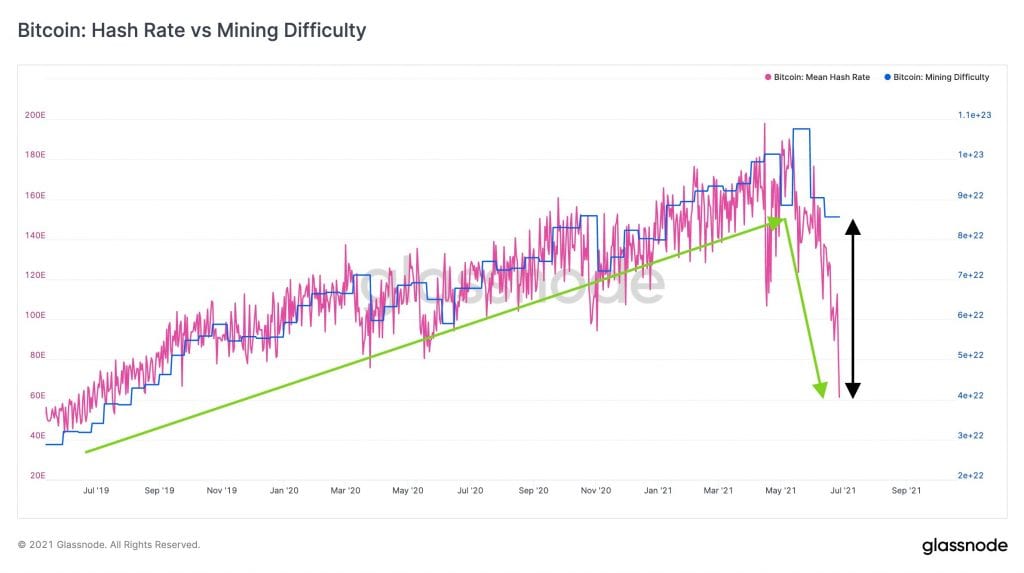
- Bitcoin mining block times sky-rocketed amid cratering hash rates
- Network activity dropped, and active addresses are reducing as well
- BTC risks falling to $24k if the current support range doesn’t hold
- But despite the bearishness, BTC has flashed a buy signal
Block Time Up, Hash Rate Down
As a consequence of Bitcoin miners moving their base out of China, it’s now taking much more time than usual to mine a BTC block. If numbers from Glassnode are anything to go by, average BTC block times (recorded yesterday) have shot up to 23.3 minutes, which is more than double the usual 10 minutes.
The result – only 58 blocks were mined yesterday, which was 60% below the 144 blocks/day threshold.
Meanwhile, the mean BTC mining hash rate crashed 70% owing to the Chinese mining exodus — from around 200 exahashes-per-second to 60 exahashes-per-second.

Glassnode called it “the largest drop in hash rate in the era of industrial mining.” Forecasts regarding mining difficulty by the firm also pointed to a 25% reduction by the following weekend.
Also Read: Are Chinese miners behind the latest Bitcoin price crash?
Network Activity And Active Addresses Dropping
Active BTC addresses have fallen to levels not seen since early 2019, data from Glassnode confirmed. It hinted at a declining interest among whales and long-term bullish investors that consider Bitcoin’s price drops as opportunities to accumulate.
Network activity has also cratered as a result. This could be a result of miners offloading their holdings on exchanges to cover their costs and earnings. Nonetheless, the accumulation spree has dialed down, and conviction-laced, deep-pocketed investors are nowhere to be seen.
While this is just data, its real-world manifestation has also shown up equally. Just today, CNBC’s Jim Cramer admitted on national television that he had increased his stake in Ethereum rather than Bitcoin. “I went back into Ethereum because Bitcoin held $30K. I like Ethereum because people actually use it much more to be able to buy things”, he said, explaining his latest crypto move.
Bitcoin Could Drop To $24,000, $15,000
Bitcoin’s current market outlook could be the reason behind the drop in new whale positions.
Amsterdam-based crypto trader and analyst Michaël van de Poppe corroborated this with his latest BTC technical setup on Twitter. Mr. Poppe thinks until buyers reclaim the $35,500 resistance level, BTC price runs a grave risk (due to lowering support with every correction) of falling to levels near $24,000.
Guggenheim co-founder and CIO Scott Minerd confirmed Bitcoin’s current bearish bias by calling a drop to $15,000 or even $10,000. However, stimulus moves by central banks around the world pushed BTC prices higher, he said in an interview with CNBC, and the benchmark cryptocurrency could spend years consolidating before moving higher.
Buy Signal
But despite the bearish sentiment, there’s a silver lining. Some whales like Scott Minerd are moving away from buying Bitcoin. But there are many more in the “line of accumulation.” A unique on-chain indicator that has flipped green for BTC confirms this.
In his conversation with Anthony Pompliano, on-chain analyst Will Clemente introduced a metric that he recently created – the OTC Desk Outflow Stoch RSI signal. According to Will, “…looks at the strength of which the trend of OTC outflows is occurring.”
The on-chain analyst explained how this metric that he created tracks the movement of “whale money” and funds held by “high net worth individuals and institutional players that navigate through OTC desks.” And how this portion of capital brings about significant moves in Bitcoin markets, and thus “…following the movement of this capital offers insightful signal to market structure.”
When the RSI breaks out of the purple highlighted range, it offers buy/sell signals. When below, sell signals (lack of OTC outflows) and conversely when above, buy signals (large amount of OTC outflows). Over the last year, these signals have been correct at a rate over 90%. We just flashed a buy signal, meaning OTC outflows have ramped up. (Big money buying the dip)
Also Read: Are whales accumulating Bitcoin between $30K and $40K?
So the “big money” pockets moving away are pre-existing Bitcoin market participants who have held positions for a long time. While some of them are moving out, more are moving in to buy cheap BTC.


